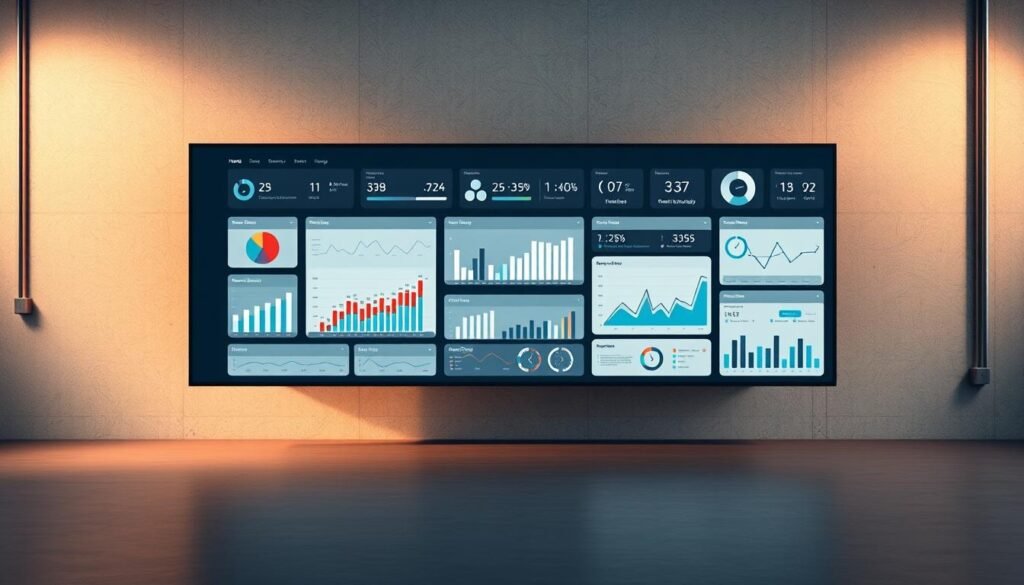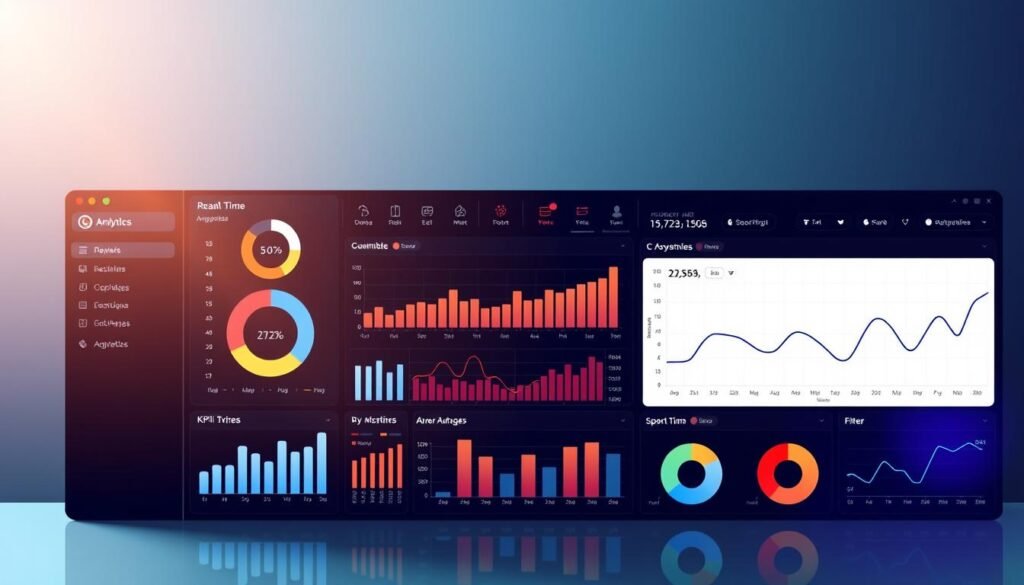Data Dashboard solutions offer a quick and efficient way to track your business performance. In just 10 minutes, you can build a dashboard that saves time, streamlines data analysis, and supports smarter decision-making.
Dashboards are vital tools for modern businesses—whether in marketing, sales, or operations. They help you visualize key metrics, monitor progress, and access actionable insights at a glance.
This guide is perfect for users seeking a fast and intuitive method to connect data sources, analyze information, and present it clearly. You’ll explore different dashboard types, learn how to prepare your data, and discover best practices for integration. We’ll also touch on real-time analytics and AI-powered insights to take your dashboards to the next level.
By the end of this guide, you’ll have a fully functional, tailored dashboard. Real-world examples from industries like healthcare, retail, and finance will show how dashboards can transform performance tracking. Let’s dive in!
Key Takeaways
- Learn how to build a dashboard in just 10 minutes.
- Understand the importance of dashboards for tracking performance.
- Discover the benefits of real-time analytics and AI-driven insights.
- Explore different types of dashboards and their applications.
- Gain insights into data preparation and visualization best practices.
Understanding the Power of Data Dashboard
Ever wondered how to turn complex numbers into clear, actionable insights? A well-designed dashboard can do just that. It’s more than just a tool—it’s a game-changer for businesses looking to streamline their operations and make smarter decisions.
Key Benefits and Performance Impact
Dashboards provide instant access to critical metrics, allowing teams to assess performance in real-time. For example, a marketing team can track campaign success rates, while sales teams monitor new client acquisitions. This immediate feedback helps businesses adjust strategies quickly and stay ahead of the competition.
Another major benefit is improved forecast accuracy. By analyzing trends and patterns, dashboards help predict future outcomes. This is especially useful for financial planning and resource allocation. “A dashboard isn’t just a report—it’s a roadmap to success,” says one industry expert.
Aligning KPIs and Metrics with Business Goals
One of the most powerful features of a dashboard is its ability to align KPIs with business objectives. Whether your goal is to increase revenue, improve customer satisfaction, or optimize operations, a dashboard ensures everyone is on the same page.
For instance, a retail business might track monthly sales against quarterly targets. By visualizing this data, teams can identify gaps and take corrective actions. This collaborative approach makes goal tracking a team effort, fostering accountability and progress.
Ultimately, dashboards transform raw numbers into a simple, visual story. They empower stakeholders at every level to make informed decisions, driving overall business success.
Choosing the Right Dashboard Type for Your Needs
Not all dashboards are created equal—choosing the right one can make all the difference. Each type serves a unique purpose, helping businesses track, analyze, and visualize information effectively. Whether you’re managing daily operations or planning long-term strategies, the right dashboard ensures you meet your goals efficiently.
Strategic, Analytical, and Operational Dashboards
Strategic dashboards are designed for executives and decision-makers. They focus on high-level metrics and long-term goals, providing a clear view of overall business performance. For example, a retail company might use this type to track annual revenue growth or customer satisfaction trends.
Analytical dashboards dive deeper into historical information. They allow users to compare trends, identify patterns, and make data-driven decisions. A marketing team, for instance, could use this to analyze campaign performance over time and adjust strategies accordingly.
Operational dashboards are perfect for monitoring daily activities. They provide real-time updates, helping teams stay on top of tasks and resolve issues quickly. A logistics company might use this to track delivery times and optimize routes.
Informational Dashboards for Clear Storytelling
Informational dashboards are all about clarity and simplicity. They present information in a way that tells a compelling story, making it easy for stakeholders to understand key insights. For example, a healthcare provider might use this type to visualize patient outcomes and improve care quality.
Each dashboard type offers unique benefits. By selecting the right one, you can ensure your team has the tools needed to track progress, meet targets, and make informed decisions. Whether you’re in marketing, sales, or operations, the right dashboard helps you stay ahead.
Preparing Your Data for a Unified Dashboard Experience
The foundation of any effective dashboard lies in its preparation. To create a seamless experience, you need to gather, integrate, and transform raw information from diverse sources. This ensures your dashboard is accurate, consistent, and ready to deliver actionable insights.
Gathering Information from Diverse Sources
Start by collecting information from various sources like spreadsheets, databases, and cloud storage. This step ensures you have a comprehensive view of your business performance. For example, sales teams might pull metrics from CRM systems, while marketing teams use analytics platforms.
Best Practices for Integration and Transformation
Once you’ve gathered your information, focus on integration and transformation. Use tools like APIs to connect different systems and ensure compatibility. Cleaning your information is equally important—remove duplicates, fix errors, and standardize formats for consistency.
Here’s a quick guide to streamline the process:
- Identify key KPIs and align them with your business goals.
- Use automated tools to reduce manual effort and improve accuracy.
- Test your information for reliability before integrating it into your dashboard.
Overcoming Common Challenges
Combining disparate information sets can be tricky. One common issue is mismatched formats or missing fields. To overcome this, use transformation tools that standardize information across sources. Another challenge is ensuring real-time updates—cloud-based solutions can help here.
By addressing these challenges, you create a unified foundation that enhances your dashboard’s clarity and reliability.
| Step | Action | Tools |
|---|---|---|
| 1 | Gather information | Spreadsheets, Databases |
| 2 | Integrate sources | APIs, Cloud Storage |
| 3 | Clean and transform | ETL Tools, Data Cleaning Software |
| 4 | Test for accuracy | Validation Tools |
Following these steps ensures your dashboard is built on a solid foundation, ready to deliver the insights your team needs to succeed.
Essential Components and Visualization Techniques
Visualizing information effectively is the key to unlocking actionable insights. The right charts and graphs can turn complex numbers into clear, compelling stories. This section will guide you through selecting the best visual elements for your dashboard and highlight best practices to ensure clarity and impact.

Selecting the Right Charts and Graphs
Choosing the right visualization depends on the story you want to tell. Line graphs are ideal for showing trends over time, while bar graphs excel at comparing values. Pie charts work well for displaying distributions, and gauges are perfect for tracking progress toward a goal.
For example, a marketing team might use a line graph to track campaign performance over months. A sales team could use a bar graph to compare quarterly revenue across regions. Selecting the right chart ensures your audience understands the insights at a glance.
Best Practices for Clear Visualizations
Keep your visuals simple and consistent. Avoid clutter by limiting the number of elements on a single chart. Use colors strategically to highlight key points, but don’t overdo it. Consistency in design helps users navigate your dashboard effortlessly.
Here are some tips to enhance your visualizations:
- Align charts with your KPIs and business goals.
- Use labels and legends to provide context.
- Test your visuals with different audiences to ensure clarity.
The Role of Visualization Tools
Modern tools make it easy to create professional dashboards. Platforms like Tableau and Power BI offer pre-built templates and customization options. These tools help you transform raw information into engaging visuals that drive decision-making.
For instance, a retail business might use a tool to create a dashboard that tracks inventory levels and sales trends. The right tool ensures your visuals are not only accurate but also impactful.
| Chart Type | Best Use Case |
|---|---|
| Line Graph | Tracking trends over time |
| Bar Graph | Comparing values |
| Pie Chart | Displaying distributions |
| Gauge | Tracking progress toward a goal |
By selecting the right charts and following best practices, you can create a dashboard that delivers clear, actionable insights. Whether you’re in marketing, sales, or operations, effective visualization helps you stay ahead.
Step-by-Step Process to Build Your Dashboard
Building a dashboard doesn’t have to be complicated—follow these steps to create one efficiently. Whether you’re tracking sales, monitoring campaigns, or analyzing operations, a well-structured dashboard provides clarity and actionable insights. Let’s break down the process into manageable steps.
Connecting Multiple Data Sources
Start by gathering information from various sources like spreadsheets, databases, and cloud applications. APIs are a great way to connect these sources seamlessly. For example, a marketing team might pull metrics from CRM systems, while sales teams use analytics platforms.
Once connected, ensure compatibility by standardizing formats. Tools like ETL software can help clean and transform raw information into a usable format. This step ensures your dashboard is accurate and reliable.
Design Best Practices and Layout Strategies
A user-friendly design is key to an effective dashboard. Begin by organizing your layout logically. Place the most important metrics at the top, followed by supporting details. Use consistent colors and fonts to maintain a professional look.
Here are some design tips to keep in mind:
- Use whitespace to avoid clutter and improve readability.
- Highlight key metrics with bold or contrasting colors.
- Test your layout with different users to ensure clarity.
Iterative improvements are essential. Gather feedback from stakeholders and make adjustments as needed. This ensures your dashboard meets the needs of your team and aligns with your business goals.
By following these steps, you’ll create a dashboard that’s both functional and visually appealing. It will help your team track progress, make informed decisions, and achieve their objectives efficiently.
Optimizing for Real-Time Analytics and AI-Driven Insights
Real-time updates and AI-driven features are transforming how businesses track performance. With the right tools, you can monitor key metrics as they happen, ensuring your team stays informed and proactive. This section explores how to optimize your dashboard for real-time analytics and leverage AI-powered insights to make smarter decisions.

Leveraging Predictive Analytics and Alerts
Predictive analytics is a game-changer for businesses. By analyzing trends and patterns, your dashboard can forecast future outcomes. For example, a sales team might use this feature to predict quarterly revenue or identify potential growth areas. These insights help you stay ahead of the curve.
AI-driven alerts take this a step further. They notify users when key metrics fluctuate, allowing for quick adjustments. Imagine receiving an alert when inventory levels drop below a certain threshold or when a marketing campaign underperforms. These timely notifications ensure you never miss a critical moment.
Here are some ways to enhance your dashboard with AI features:
- Use predictive models to forecast trends and set realistic goals.
- Enable automated alerts for KPIs that require immediate attention.
- Integrate AI-powered insights to uncover hidden patterns in your data.
Timely information delivery is crucial for operational efficiency. A dashboard that updates in real-time ensures your team always has the latest insights. Whether you’re tracking sales, monitoring campaigns, or managing resources, real-time analytics keep you in control.
Finally, consider using software with native mobile and AI integration. This allows you to access your dashboard on the go and leverage advanced features without additional setup. By optimizing for real-time analytics and AI-driven insights, you’ll empower your team to make faster, more informed decisions.
Industry-Specific Dashboard Examples and Use Cases
Different industries have unique needs, and dashboards can be tailored to meet those specific requirements. Whether you’re in healthcare, retail, or financial services, a well-designed dashboard helps you track key metrics and make informed decisions. Let’s explore how various sectors use this powerful tool to achieve their goals.
Healthcare, Retail, and Financial Services
In healthcare, dashboards are essential for monitoring patient care and operational efficiency. Key metrics like patient wait times, treatment success rates, and bed occupancy are tracked to improve service quality. For example, a hospital might use a dashboard to identify bottlenecks in patient flow and allocate resources effectively.
Retail businesses rely on dashboards to analyze shopper behavior and sales trends. Metrics such as foot traffic, conversion rates, and inventory levels help retailers optimize their operations. A retail chain could use a dashboard to track seasonal sales and adjust marketing strategies accordingly.
Financial services use dashboards to compare revenue and margin data. Metrics like loan approval rates, investment returns, and client acquisition costs are critical for decision-making. A bank might use a dashboard to monitor loan performance and identify profitable investment opportunities.
Marketing, Sales, and Operational Dashboards
Marketing teams use dashboards to track campaign performance and lead generation. Metrics like click-through rates, social media engagement, and conversion rates provide valuable insights. For instance, a marketing team might use a dashboard to measure the success of a new ad campaign and adjust targeting strategies.
Sales dashboards focus on tracking revenue and client acquisition. Metrics such as sales pipeline progress, deal closure rates, and customer lifetime value are key. A sales team could use a dashboard to monitor quarterly targets and identify high-potential leads.
Operational dashboards help businesses streamline daily activities. Metrics like production output, delivery times, and resource utilization are tracked to ensure efficiency. A logistics company might use a dashboard to optimize delivery routes and reduce costs.
Each industry’s dashboard design is tailored to its specific needs, ensuring stakeholders have the insights they need to succeed. By leveraging this tool, businesses can streamline decision-making processes and achieve their goals more effectively.
Conclusion
Creating a powerful tool to monitor your business performance doesn’t have to be time-consuming. With the right approach, you can build a functional dashboard in just 10 minutes. This guide has walked you through every step, from selecting the right type to optimizing for real-time insights.
By choosing the appropriate visualization techniques and aligning your metrics with your goals, you can transform raw information into actionable insights. Whether you’re tracking sales, managing operations, or analyzing marketing campaigns, a well-designed dashboard helps you stay on top of your game.
Now it’s your turn to apply these strategies. Start building your own customized dashboard today and see the difference it makes. For more advanced techniques, explore our guide on interactive dashboards to take your analytics to the next level.
Thank you for reading! We hope this guide empowers you to make smarter decisions and achieve your business goals with ease.





















